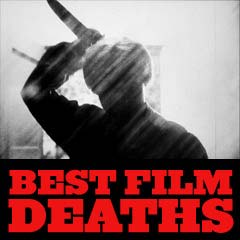
|
Deaths Scenes 1986 |

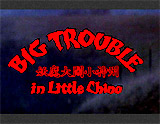
|
Big Trouble in Little China (1986) In John Carpenter's comic martial-arts film, villainous, immortal sorcerer Lo-Pan (James Hong) died in his throne room underneath Chinatown, where he led a group of bandits called "Wing Kong." Truck driving hero Jack Burton (Kurt Russell) - who had lipstick smudged all over his lips after kissing love interest/lawyer Gracie Law (Kim Cattrall) - had his own knife flung at him by Lo-Pan (who had noted: "Good knife"), with the threat of dying:
With whiplash accuracy, Burton quickly caught the knife and threw it back into the forehead of Lo-Pan. When Lo-Pan fell backwards dead, the many golden buddha statues lining his throne room crashed in a row (like dominos) around Jack, who stood amazed and told Gracie proudly and confidently:
|
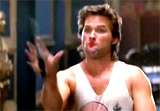  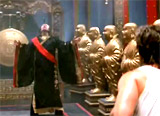 Forehead Knifing |
||||||||||||||||||||

|
Big Trouble in Little China (1986) Angered and also dishonored by Lo-Pan's death because he couldn't provide protection, Asian martial-arts master and powerful magician Thunder (Carter Wong) (one of the Three Storms) physically expanded in rage, inflated and exploded (off-screen) in an amusing death scene. First, his facial cheeks and his feet swelled to an enormous size. Then his entire head filled with hot steamy air before he literally blew up. |
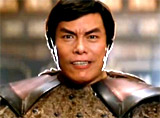 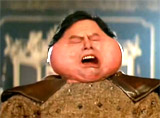 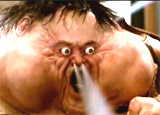 Thunder's Swelling |
||||||||||||||||||||
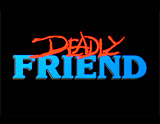
|
Deadly Friend (1986) In this science-fiction, "Frankenstein-like" horror film by director Wes Craven, Samantha Pringle (Kristy Swanson) was abusively brain-damaged by her father and lapsed into a coma. Her body was implanted with an AI chip from a neighbor's pet robot named Bee Bee (or BB), and she became reanimated, robotic and superpowerful herself. In the film's most infamous death scene, Samantha vengefully attacked her mean, crotchety, reclusive next-door neighbor Elvira Parker (Anne Ramsey). The film was prefaced by a basketball mysteriously bouncing into Elvira's living room. Elvira grabbed her shotgun and warned any intruders but found no one. Samantha emerged in the room, threw her against a wall, picked up the basketball, and delivered one swift toss to Elvira's head. She watched as Elvira's head exploded, and the decapitated, headless corpse (splattering blood) staggered and wriggled to the floor. In another memorable scene, Samantha had been transported to a morgue after taking a policeman's bullet to save her boyfriend/creator, computer whiz-kid Paul Conway (Matthew Labyorteaux). Paul snuck into the morgue, located her drawer, slid it out, and removed the sheet covering her body. He spoke to her: "Hey Sam, I'm gonna get you out of here."
Although she was thought to be dead, suddenly she grabbed Paul's neck (the film's shock ending) and started to strangle him. Her skin stretched away, and her robotic skeleton underneath became visible under her face and arms. Becoming an evil version of Bee Bee, she entreated him with a whispered invitation, as he screamed:
|
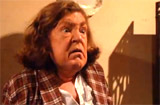 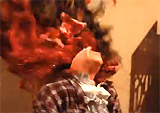 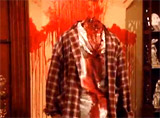 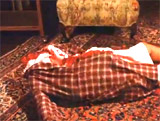 Elvira's Head Exploded with Basketball Toss |
||||||||||||||||||||
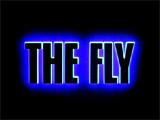
|
The Fly (1986) Director David Cronenberg's science-fiction horror film was a remake of the equally-exciting 1958 film of the same name. In both cases, they told how an eccentric scientist, Dr. Seth Brundle (Jeff Goldblum) in this film, had accidentally merged himself at a molecular-genetic level with an ordinary housefly during a teleportation incident using an experimental telepod device. His new name was Brundlefly. His momentous death scene was prefaced with mutating human-fly Seth's mutilation of his girlfriend's editor and former lover Stathis Borans (John Getz). He came by the lab to protectively and heroically rescue Seth's pregnant lover/girlfriend, a magazine reporter named Veronica "Ronnie" Quaife (Geena Davis). Seth vomited digestive enzymes onto his left hand and right foot. The corrosive formic acid caused those body parts to dissolve. Seth, whose slowly degenerating body was then completely transformed into a human fly, was compelled to try and combine his hideous body with that of Veronica's (and her unborn child) ("You, me, and the baby, together...it will be the ultimate family, a family of three joined together in one body, more human than I am alone"). His plan failed when he was inadvertently fused with metallic components of his telepod device. The seriously-wounded Borans had disconnected the power lines to Veronica's telepod with a shotgun blast, causing a shower of sparks and aborting her connection to the fusion process. In the poignant final scene, anguished and completely disfigured 'Seth' flopped out of the telepod and wordlessly begged Veronica to kill him by guiding the shotgun's muzzle to his body with a deformed claw. He wished for her to end his monstrous life with a mercy killing after the failed transport, although she at first begged:
He raised his head for one more pitiful look before she tearfully raised the shotgun and blew the suffering Brundlefly's head to bits with one shot. Following her accomplishment of the merciful act of compliance, she collapsed on her knees to the floor, as the film ended.
[Note: In the original 1958 film, the fly-mutated scientist Andre Delambre (David Hedison) - a human with a fly head - was suicidally killed in a hydraulic press machine, assisted by his wife Helene (Patricia Owens). In an alternative explanation, miniaturized Andre - now a fly with a human head - was trapped in a spider's web (the so-called "Help me! Help me!" scene) and smashed to death with a rock by police inspector Charas (Herbert Marshall).] |
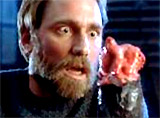 Dissolving of Left Hand  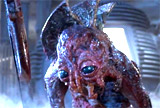 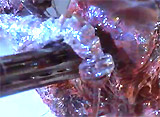 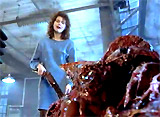 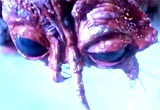 The Pitiful Brundlefly Before Being Shot |
||||||||||||||||||||
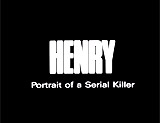
|
Henry: Portrait of a Serial Killer (1986) (released in 1990) There were many sickening, brutally-violent, documentary style, cinema-verite killings (over a dozen) by psychotic murderer Henry (Michael Rooker) in this highly-controversial, low-budget and notorious 82 minute film. Serial killer Henry's random crime spree was loosely based on real-life murderer Henry Lee Lucas (who eventually died in prison in 2001). Henry's background partially accounted for his murderous streak - his abusive mother (who Henry claimed he had stabbed to death on his 14th birthday) was a "whore" who forced young Henry to wear a dress and watch her having sex with her many customers in their house. Interspersed in the film's action were still shots of Henry's trail of carnage in Illinois - they were the death poses of many of the murder victims (killed off-screen), sometimes with accompanying sounds of their screams or death struggle:
Dim-witted, paroled, roommate prison-buddy Otis (Tom Towles) first witnessed Henry's cold-blooded dirty-work when they picked up two Chicago prostitutes (Mary Demas and Kristin Finger) and he murdered them in their car by snapping both of their necks, and then dragged their bodies into a dark alleyway (Henry later rationalized about his killings: "It's always the same and it's always different... It's either you or them, one way or the other"). Henry repeatedly stabbed smart-alec TV salesman/fence (Ray Atherton) with a soldering iron (first in the hand) and smashed a cheap $50 B/W TV over his head, after which Otis plugged in the set to end his life by electrocution. The two stole a video-cam recorder and a high-priced TV set. After Otis' frustrated statement, "I'd like to kill somebody," he randomly shot a 'Good Samaritan' (Rick Paul) in an overpass tunnel on the side of the downtown freeway, to make himself "feel better." There were the disturbing killings of a helpless family (a couple and their son) (Lisa Temple, Brian Graham, and Sean Ores) in their suburban home, videotaped for repeated viewings by both Henry and partner-in-crime Otis. Henry found Otis strangling and raping his sister Becky (Tracy Arnold) - Henry's 'girlfriend.' She defended herself by stabbing Otis in the right eye with the sharp end of a haircomb. Then Henry joined in and stabbed Otis in the chest as Becky watched. Henry cut off Otis' head in the bathtub, and his body parts were dumped in a river.
On the move with Becky, the two spent the night in a motel. The next morning, Henry left the motel by himself (had he killed Becky in the room and dismembered her body?) and deposited Becky's heavy blood-stained suitcase in a roadside ditch (was Becky inside?) |
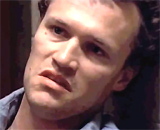 Henry Lee Lucas (Michael Rooker)  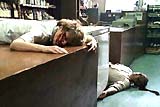 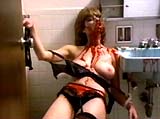  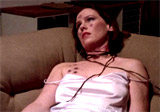 Still Images of Murder Victims  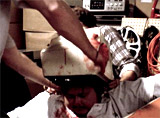 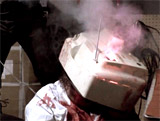 Smashed TV Set Into Head of Salesman 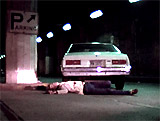 Killing of Good Samaritan 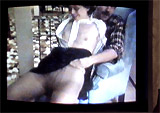 Videotaped Murder of Family |
||||||||||||||||||||
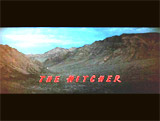
|
The Hitcher (1986) This brutally violent and scary horror-thriller film by director Robert Harmon featured one of the most horrific and infamous death scenes ever filmed (it occurred off-screen, but was no less grotesque). While driving from Chicago to San Diego to transport a rental car, Jim Halsey (C. Thomas Howell) picked up a strange, violent terrorizing, psychopathic 'hitcher' named John Ryder (Rutger Hauer). As he opened the car door, he stated: "My mother told me to never do this" - the film was possibly a nightmarish vision of what could happen in the scenario of picking up a dangerous hitch-hiker. After a few stalking and murderous encounters with the relentless Ryder along the way, Jim entered the Longhorn Restaurant, a roadside diner/gas station before it was officially open, where the young, friendly blonde waitress Nash (Jennifer Jason Leigh) served him a meal of fries and a cheeseburger. When he shockingly found a severed finger in the fries - it was a tip-off that Ryder was in the vicinity. In a tense cat-and-mouse game, Ryder continually framed Jim for the crime spree murders he had committed of various victims, including police officers. The sweet waitress Nash became a victim of serial killer Ryder when she was tied hand and foot by chains between the front end of a trailer-truck and a detached semi-trailer. She screamed out: "Please don't!" In the cab of the truck with his foot on the clutch, Ryder challenged everyone to shoot him (an officer had cautioned: "If we shoot him, his foot is gonna come off that clutch and that truck is gonna roll"). Jim tensely entered the cab, where Ryder suggested: "The gun is loaded. Go for it! Go ahead, pick it up." Ryder revved the engine and threatened to accelerate. As instructed, Jim picked up the gun and pointed it at Ryder, but couldn't squeeze the trigger (fearing that "she'll die"). Ryder was disgusted: "You useless waste," let up the clutch, and accelerated anyway. With a horrible tearing and stretching sound, Nash was pulled in two (the gore remained off-screen) when Ryder's foot came off the clutch. The last view was of her bound hands. The suspenseful film concluded with Jim successfully finding ultimate vengeance upon the seemingly-dead hitcher by blasting him with a shotgun, and in the process becoming as lethal as Ryder had been. |
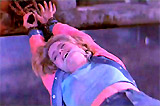 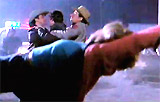 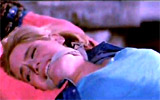  Nash Torn in Two 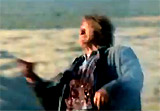 Shot-gun Revenge on Ryder |
||||||||||||||||||||
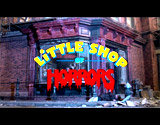
|
Little Shop of Horrors (1986) This was a remake of director Roger Corman's earlier low-budget black comedy Little Shop of Horrors (1960), which also became the basis for the off-Broadway musical in the early 80s. In the story, nebbish NYC florist shop assistant Seymour Krelbourn (Rick Moranis) owned a hungry, gigantic venus flytrap, named Audrey II (voice of Levi Stubbs) after his infatuated love for co-worker Audrey Fulquard (Ellen Greene). The strange and interesting plant Audrey II craved and demanded Seymour's blood as food. When Audrey's abusive and sadistic Elvis-like dentist and greaser boyfriend, Dr. Orin Scrivello D.D.S. (Steve Martin), treated her badly in Seymour's presence, Seymour was convinced to kill Scrivello. In the dentist's office during an appointment, Seymour balked at killing Scrivello with a revolver, when he watched as the hysterical, over-the-top dentist put on a "special gas mask" because he "really wanted to enjoy this." But then he accidentally asphyxiated himself on laughing (or "giggle") gas (nitrous oxide), due to a malfunctioning control valve on the tank - and he literally collapsed and died laughing in front of Seymour. Seymour dragged the dentist's body (stashed in a canvas bag) down the street back to the florist shop, where the ravenous plant called out: "Feed Me!" In the back of the shop, Seymour began to chop up the body with an axe, when the florist shop owner, Mr. Mushnik (Vincent Gardenia) saw his silhouette and assumed that he was an axe-murderer. However, he fled in fear without being seen. Seymour dragged the bloody body parts to Audrey II, where the open-mouthed, voracious, blood-seeking plant gladly feasted on them.
|
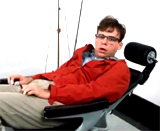 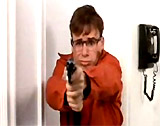 Seymour - Ready to Shoot Dr. Scrivello in Dentist's Office  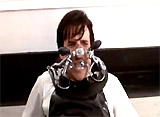 Dentist Dr. Scrivello Accidentally Dying From Laughing Gas |
||||||||||||||||||||

|
In this thriller based on Thomas Harris' novel Red Dragon, part of the backstory was about obnoxious, sleazy and unethical National Tattler tabloid reporter Freddie Lounds (Stephen Lang), who had previously covered the Doctor Hannibal Lecktor (Brian Cox) case for the tabloid. He had also written a paperback about the convicted psychopathic serial killer, who was now imprisoned. The newest serial killer on the loose was eventually identified as Francis Dollarhyde (Tom Noonan), nicknamed "The Tooth Fairy" because he left bite-marks at crime scenes. Complications arose in the most recent serial murder case when Lounds published a front page story in The National Tattler about the fact that FBI profiler agent Will Graham (William Petersen) had returned: "FBI Manhunter Graham, Consults Hannibal Lecktor, The Fiend Who Tried to Kill Him," accompanied by a picture of the profiler outside Lecktor's prison. Lounds was actually asked to collaborate on the case, to work with the police and publish material about how the "Tooth Fairy" was probably gay, and had molested all of his male victims, and was possibly impotent with members of the opposite sex. It was also mentioned that in the killer's past, he may have had sexual relations with his mother. The most recent edition of The National Tattler displayed a picture of Graham and reporter Lounds on the front page, next to Lounds' article entitled: "FBI Pursues Pervert." Lounds was ambushed by the killer in an underground parking garage, chloroformed, and kidnapped. He was blindfolded and strapped in a wheelchair, and taunted: "According to you, I'm a sexual pervert. 'An animal,' you said." The tall, near-albino, crazed "Tooth Fairy" with a cleft-palate and scraggly white hair wore a ladies' sheer stocking mask over his head and eyes, and forced Lounds to watch a slideshow beginning with a painting of William Blake's The Great Red Dragon and the Woman Clothed in the Rays of the Sun, with further pictures of his transformed female victims (Mrs. Leeds, Mrs. Jacobi). The killer told Lounds:
Lounds was forced to record a note in which he admitted his writings about the Red Dragon were lies, and that Graham had coerced him to write the untruths (part of the note: "He will be more merciful to me than to you. You will lie awake in fear of what the Red Dragon will do"). The "Tooth Fairy" then announced that Lounds' promise to tell the truth would be sealed: "We'll seal your promise with a kiss." The screaming Lounds had his lips bitten off (off-screen) and then was set ablaze in the wheelchair. He was rolled down a steep underground parking garage ramp towards the camera - his death occurred later (offscreen) in a hospital. |
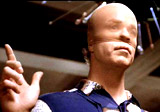 "The Tooth Fairy" - Francis Dollarhyde 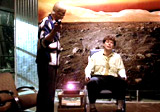 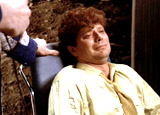 Reporter Freddie Lounds Kidnapped and Taunted 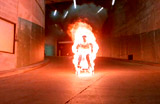 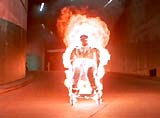 Lounds' Wheelchair Set Ablaze |
||||||||||||||||||||
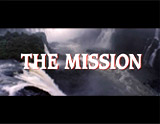
|
The Mission (1986, UK) This historical drama (winner of the Cannes Film Festival's Palme d'Or, and Oscar winner for Best Cinematography) was set in the mid-1700s. It told about the strenuous efforts of Jesuits in the Catholic Church to convert natives ("Indians still existing in their natural state") in South American jungle areas (the Guarani) to Christianity and to bring civilization. The film opened before the credits with Cardinal Altamirano (Ray McAnally) dictating a description of the state of affairs regarding the missionary efforts. It was presented with an evocative image of a martyred Jesuit missionary, crucified and tumbling over Iguazu Falls, a massive waterfall, 200 feet to his death:
South American natives hoisted up the priest, stripped to the waist and tied to a giant, rough-hewn wooden cross. They carried him to a body of water, and tossed him in. Face-up, he slowly floated downstream until tumbling over the waterfall's edge to his death. During the title credits, a new Spanish Jesuit priest, Father Gabriel (Jeremy Irons) arrived, as the voice-over dictated letter continued, to scale the rocky cliffs next to the waterfall and enter the native community to carry on the work:
|
 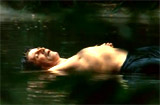 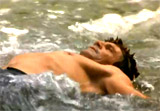 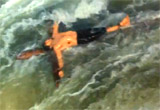 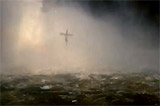
Martyred Jesuit Missionary |
||||||||||||||||||||

|
Platoon (1986) Director Oliver Stone's Best Picture-winning film was a harrowing, visceral, realistic, and visually-shattering Vietnam-war film. During a Vietnamese jungle operation that became a punishing firefight ambush, callous, scar-faced Staff Sergeant Barnes (Tom Berenger) ordered an airlift evacuation for all the dead and wounded in his platoon. Then, the sociopathic Barnes stalked after Sgt. Elias (Willem Dafoe), who had become separated from the platoon in the deep jungle. When he located him, he calmly shot his long-time opponent three times in the chest, and left him for dead. The malevolent Barnes told questioning Chris (Charlie Sheen) who came upon him:
At the helicopter pickup area, gurneys were quickly loaded with the dead and dying before they swiftly pulled away. But as they departed, Chris noticed a seriously-wounded soldier ("They've got Elias") being pursued, retreating, and running (in slow-motion) from a group of NVA soldiers firing at him (Radio operator: "There's still one on the deck down there"). An overpowered Sgt. Elias emerged and staggered into view, falling and crawling along, as the helicopters provided some firepower to assist.
Although there was an attempt to rescue Elias, who adopted an iconic, slow-motion crucifixion martyr pose when he was struck by VC enemy fire, he was fatally hit and died in grandiose fashion before he could be taken aboard (while Samuel Barber's Adagio For Strings played). |
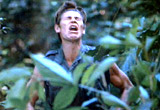 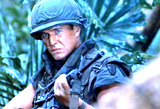 Sgt. Barnes Shooting Elias 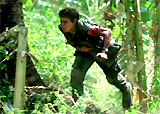 Wounded Elias Running Into View |
||||||||||||||||||||

|
Top Gun (1986) Director Tony's Scott's acclaimed action film told about daring young pilots at the US Navy's elite fighter weapons school. It featured adrenaline-pumping aerial flight scenes, nicknamed characters, super-patriotic and pro-US attitudes, a popular soundtrack, and very quotable dialogue: (e.g., "I feel the need, the need for speed!" or "You can be my wingman anytime") - and was the # 1 film at the box-office (domestic) in 1986. During a failed flight, naval pilot Lt. Nick 'Goose' Bradshaw (Anthony Edwards) died following a tailspin and botched ejection when he hit his own cockpit canopy and was instantly killed. Both parachuted into the water, where fighter pilot Pete 'Maverick' Mitchell (Tom Cruise) cradled in his arms his buddy who was lying on top of him. He hesitated to let him go before he was being hoisted up into a rescue helicopter. |
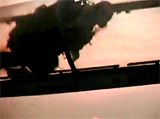 Goose's
Ejection From Cockpit Botched Goose's
Ejection From Cockpit Botched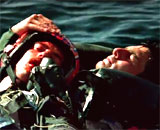 Maverick
Holding His Dead Buddy "Goose" in Water Maverick
Holding His Dead Buddy "Goose" in Water |
||||||||||||||||||||
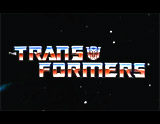 
|
Transformers: The Movie (1986) This feature-length animated film told about conflict between two armies of transforming giant humanoid robots (or transformers), set in the year 2005, to determine the fate of the planet Cybertron: the Autobots vs. the Decepticons. Valiant 'good-guy' and beloved hero Autobot Optimus Prime (voice of Peter Cullen) suffered an unexpected and surprise death when he was killed in the first third of the film. He was battling the 'bad-guy' Decepticons led by Megatron (voice of Frank Welker) and StarScream (voice of Chris Latta), to avoid being defeated by a giant, mechanized, planet-consuming robot called Unicron (voice of Orson Welles in his last film role). As Optimus Prime died, he told those around him:
Optimus Prime passed on the "matrix of leadership" (a legendary glowing talisman) to Ultra Magnus (voice of Robert Stack). He promised victory in the future:
Then, Optimus Prime's blue eyes flickered and dimmed, he turned dark and gray, and his head went limp.
|
 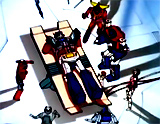 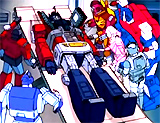 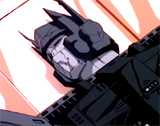 Death of Optimus Prime - Passing on the "Matrix of Leadership" |
||||||||||||||||||||
(chronological by film title) Intro | 1915-1929 | 1930-1933 | 1934-1938 | 1939 | 1940-1942 | 1943-1945 | 1946-1947 | 1948-1949 1950-1952 | 1953-1955 | 1956-1957 | 1958-1959 1960-1961 | 1962-1963 | 1964-1966 | 1967-1968 | 1969-1970 1971 | 1972 | 1973 | 1974 | 1975 | 1976 | 1977-1978 | 1979 1980 | 1981 | 1982 | 1983 | 1984 | 1985 | 1986 | 1987 | 1987 | 1988 | 1989 1990 | 1991 | 1992 | 1993 | 1994 | 1994 | 1995 | 1995 | 1996 | 1997 | 1998 | 1998 | 1999 2000-2001 | 2002 | 2003 | 2004 | 2005 | 2006 | 2007 | 2008 | 2009 | 2010 | 2011 |